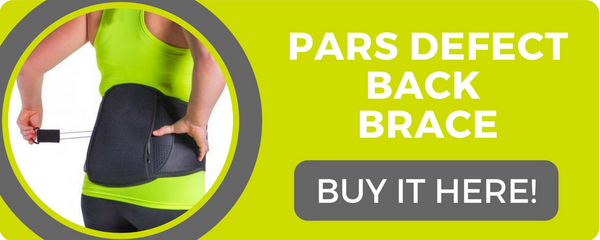Have an L4-L5 Pars Defect in Your Spine? It Might be Spondylolisthesis
What Is a Pars Defect?
 To start, in order to understand what a pars defect is, you probably want to know more about the anatomy of your pars interarticularis. Your pars interarticularis is a bony bridge-like structure that is placed in between two joints in your vertebrae.
To start, in order to understand what a pars defect is, you probably want to know more about the anatomy of your pars interarticularis. Your pars interarticularis is a bony bridge-like structure that is placed in between two joints in your vertebrae.
So now what is a pars defect? A pars defect is typically found in the lumbar or lower region of your spine and refers to a break in your bone. If you’re experiencing pain radiating in or around your lower back, it’s possible you have injured or strained your pars interarticularis.
If you think you’ve injured your pars defect, it’s very likely you have spondylolysis or spondylolisthesis, two very related spine conditions. Spondylolysis is a result of the separation of the pars interarticularis. This condition refers to small stress fractures in the bones of the spine, which can cause the bones to weaken to such an extent, that one shifts out of place. When this happens, the progression from spondylolysis to spondylolisthesis occurs.
Spondylolisthesis is when one of your bones in your vertebra slides forward or backward over the bone next to it. The level of slippage can be easily measured by using a grading scale for spondylolisthesis. The grade of your condition can be divided into five different levels: grade I, grade II, grade III, grade IV, and grade V. Grade I slippage being the least severe, and grade V having completely fallen off the next vertebra. Read more on each level of slippage.

Don't think you have spondylolisthesis or spondylolysis? There are numerous other back injuries that may cause similar symptoms or discomfort.
What Does L4-L5 Spondylolisthesis Mean?
 L4-L5 spondylolisthesis, or a type of spondylolisthesis where the fourth lumbar vertebrae (L4) slips out of place onto the fifth lumbar vertebra (L5), is worthy of an article in and of itself. Why? You might be wondering. Well, of the five types of spondylolisthesis, degenerative (age-related) is the most common. This typically affects the low back, with L4-5 spondylolisthesis being the most common. Degenerative spondylolisthesis is a result of the natural aging process in which your joints and bones become weak.
L4-L5 spondylolisthesis, or a type of spondylolisthesis where the fourth lumbar vertebrae (L4) slips out of place onto the fifth lumbar vertebra (L5), is worthy of an article in and of itself. Why? You might be wondering. Well, of the five types of spondylolisthesis, degenerative (age-related) is the most common. This typically affects the low back, with L4-5 spondylolisthesis being the most common. Degenerative spondylolisthesis is a result of the natural aging process in which your joints and bones become weak.
Adolescents dealing with slippage at l4-5 typically experience the isthmic form of spondylolisthesis, where stress fractures are to blame for the sliding of the vertebra. More specifically, the pars interarticularis of the facet joints is fractured – which you know as spondylolysis.
Spondylolysis might be caused by a growth spurt or high contact sports that require frequent hyperextension of the spine (e.g., gymnastics, football linemen) or activities that put high amounts of force on the back, such as weightlifting.
The most common type of isthmic spondylolisthesis is L5-S1 spondylolysis, which is when the lowest lumbar vertebra slides onto the sacrum. However, instances of spondylolysis L5-L4 also occur. The defect of the pars interarticularis might occur on one or both sides of the back, known as unilateral or bilateral L5 spondylolysis, respectively.
Other, less common types of spondylolisthesis include traumatic, pathologic (a tumor or infection), or dysplastic (defect that is present from birth).
Symptoms of Spondylolisthesis L5-S1 & L4-L5
You may well have slippage of the vertebrae and be symptom-free at the same time. For most individuals, symptoms usually don’t arise until adulthood. The trip to the doctor typically occurs once slippage has begun to put some pressure on the spinal nerves or when an individual begins experiencing back pain associated with activities.
This discomfort is often due to the slippage of the vertebra encroaching on other components of the spine. When the slippage narrows the space within the spinal canal, this is known as spinal stenosis. This becomes problematic when the nerves are impacted or when the sciatic nerve of the back is affected, more commonly known as sciatica.
Symptoms of L4-L5 spondylolisthesis typically include:
- Pain or stiffness in the lower back or legs
- Tight hamstrings and possibly weakness in the legs after standing or walking for a long time
- Numbness and/or tingling of the legs are also possible symptoms if the nerves of the spine are compromised
- Muscles spasms might also occur
Treatment for L4 L5 Spondylolisthesis
Nonsurgical treatment involves taking anti-inflammatory medications (possibly including an epidural injection) to help deal with the swelling and inflammation of spondylolisthesis.
In addition, as well as engaging in physical therapy, exercises for spondylolisthesis L4 on L5 to help strengthen and stretch the muscles of the back and abdomen can help reduce the amount of strain on the low-back.
Similarly, wearing a spondylolisthesis brace for the low back can also help rest and immobilize your back in order to prevent further injury. Back braces for l4 and l5 support can help reduce strain on this area of the body and slow slippage of the vertebra.











